The Way of Flowers (Ikebana)
Practicing Zen Awareness with Flowers
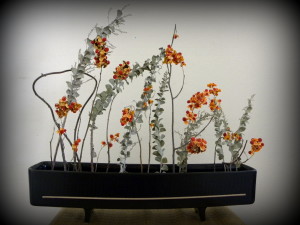
We do not currently have any Ikebana workshops scheduled for 2024.
Information about our last workshop:
MORIBANA — WITH PUSSY WILLOWS
Moribana ill be the classic arrangement style of the August Ikebana Class.
The workshop will be designed to introduce Moribana to those who have not had ikebana or this style before, as well as to further develop the skills of those who studied it at a previous workshop.
This class is for both beginners and those who have previous experience, for men, women and teens.
The style uses lshallow, flat vases suitable for evoking a water landscape. The class this time will feature the arrangement of pussy willows, perfect for the upcoming autumn and fall months.
Teacher

Virgie Luchsinger is a Professor of Ikenobo Ikebana. She has studied Ikebana in Chicago and Kyoto. For further information about her qualifications and background, see our leadership page.
Highlights of the Workshop:
All participants will be guided in making three arrangements.
The total fee for workshop, flowers, and handouts is $45.00.
The workshop is designed for 4 to 12 people.
There will be handouts with instructions and samples.
There will be two talks, discussion, arranging, individual assistance and refreshments.
Participants take their arrangements home.
What to Bring:
1) Vases
Participants are asked to bring their own vases. The top photo (above) is an example: ideal dimensions would be 12 inches long by 2 inches wide with 2 inches depth. However, it can be difficult to find rectangular shapes, so an oval vase will also also work. A key feature is sufficient depth to hold the kenzan and water. (Some kitchen or serving dishes might work if they have sufficient depth.) For newcomers or those with no vases, a few inexpensive, used vases will be available for loan during the workshop. But we do encourage those who can to bring their own vases from home (or shop for one) because it makes it easier to enjoy the arrangements at home after the workshop. See below for two other examples of vases.
2) Clippers
Please bring your own Ikebana clippers or ordinary garden pruning shears. Inexpensive garden clippers are available at Ace, Target, etc. For those who do not have their own, we will have a few for use during the workshop.
3) Kenzan (frog)
Please bring your own Kenzan (frog). Rectangular is best, but any shape will work as long as they fit inside your vase. You will probably need two or three. Though more expensive, the traditional Japanese kenzan are recommended because they are strong enough to support branch material. If you wish to purchase them from us, please order them at least one week in advance for $20 each (see below). We will then have them ready for you at the workshop. We will have a few used kenzan available for use during the workshop by newcomers or those who do not have any, but our supply is limited.
Register
Use the arrow in the Options box below to scroll through the workshop choices
REGISTRATION FOR THE WORKSHOP:

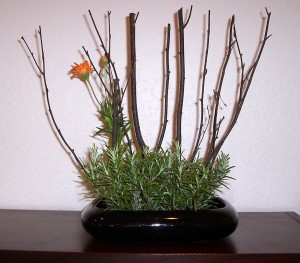
(Left) Lily of the Valley Jiyuka by Virgie on the Zen Center altar in a
shorter, deeper rectangular vase.
(Left) Jiyuka by Virgie using branch material, rosemary and daisy
in an oval vase.
Other Arrangements:
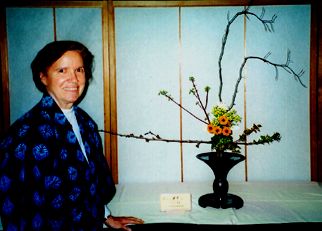
(Left) Rikka Style by Virgie
The three arrangements below are by Sr. Virgie Luchsinger:
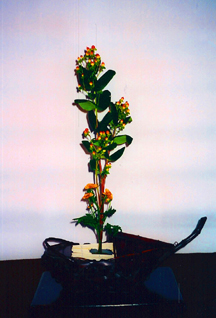
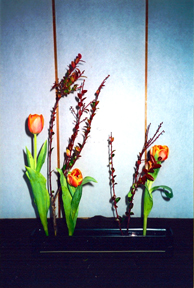
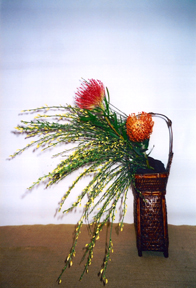
The morning glories
ignore our drinking party
and burst into bloom.
(–Basho)
Ikebana in the Zendo
By Virgie Luchsinger
Appreciation and arrangement of flowers is an appropriate focus for the practitioner of Zen. It immediately moves my heart to speak about this and to enter into some of the items that are of primary importance in the actual arrangement of flowers, because I love it, enjoy it so much and hope that others will also.
The first thing to recognize is that it is an art to be learned, to be cultivated.
It is definitely a matter of awakening the heart to flowers as a part of all nature, whether outside or in the Zendo. The basis of the Ikebana tradition is to present flowers in such a way that one is drawn to the beauty of nature. It is called Kokoro. Quite simply, it is a movement of the heart, quickened by the acknowledgement of being connected to nature: to all of nature, to the universe. In my study with Sensei Ikka Nakashima, my teacher in Chicago, and in my experience of Ikebana practice, there is a mandate to live this life that is connected to nature. In fact nature and life are the same. It is one practice.
The story comes to us that Ikenobo, who founded Ikebana, went to China and was enthralled by the beautiful scenery. The noble mountains reached to the heavens.
The streams parted through the hills, and the majesty of it all permeated the monasteries, the towns and country side. When he returned to Japan he desired to recreate that beauty through flower arranging. The Japanese garden, in many different configurations, small to even smaller, is a way of bringing nature into dense city living. Flower arrangements extend that possibility. And ever since, color, form and shape of flowers have become a study for our attention and appreciation.
Cultivation of this appreciation is enhanced by our remembering that when we see a flower, just one flower, we are seeing the universe. We are connected with the universe. The height of this cultivation is when our memory has so instantly connected the essence of a flower to the universe that we bypass, as it were, the effort to remember and we just know it! We have, in fact, become one with the beauty, form and presentation of the flower. The movement of our heart, Kokoro, has been completed in this moment. We have touched the universe. We have become the flower and one with the universe.
So how do we master Ikebana? This begins when we first handle the material, whether it is a branch, which is an extension of the flower, or whether it is just green leaves or the flower itself. Gently we look over each stem, leaf and blossom. We open our eyes to it letting each part of the material touch our hearts with its energy. Kokoro! We imagine how each piece will enhance the other by unique qualities. Some are water materials, for example, willow and bamboo. Some are grass materials with flexible spikes in graceful arches. Others are inflexible materials, for example, cherry tree branches and lilac branches. Such an infinity of qualities reflect the infinite universe.
An important part of an arrangement is making sure that each flower is seen; that flowers are not bunched; that leaves are not so abundant that they take away from the balance of the flower line. As a result the key is not many flowers but few flowers. We are not distracted by complexity, but attracted by simplicity. In flower arranging we guard against the greed of wanting more. Rather we cultivate presence to One Flower.
The attention to “oneness” is further enhanced by repeated use of three elements: Shin, Soe, and Tai. The ancients saw in the law of fertility that three elements are basic to life. The union of two blossomed into an offspring. This occurs in plants, animals and so on. In Ikebana Shin reaches to the heavens but is firmly anchored. Literally, Shin means reality. The word Soe means support. It is the complement of Shin. Tai is the shortest. Each is placed at an angle to the other. Dimension, not flatness, is primary.
If these three elements were dots and you connected them, a triangular shape would be formed. See how this differs from Western arrangements, which collects a mass of flowers in a round shape. We call it a bouquet. In Ikebana flowers are placed to look up at the sun. Western arrangements look out at the viewer. Ikebana leans flowers forward expressing movement. Fullness is at the bottom near the rim of the vase. Western forms are heavy at the top.
Most often in Ikebana we make arrangements of flowers and branch material to resemble nature itself. We have a style called Moribana where space is left to one side of a wide, flat vase so that a lake is depicted. Flowers here resemble a wooded area reflecting in the water. In Rikka style we make a cosmopolitan arrangement with branches reaching to the sky, some are at an angle resembling hills, and others are arranged horizontally like streams running down to the city. The city is depicted in the center near the rim of the vase full of flowers at alternate lengths leaning forward. The vase holding the flowers becomes the earth where flowers are rooted: vases are earthly colors.
All of what I have been saying gives an artistic perspective of Ikebana. The student is deepened by the art itself. The quiet work of flowers calls forth emotion through color, beauty and form. Nasake–compassion–emerges. Noticing nature increases Nasake. Branches in the wind, petals changing color, rain refreshing the earth: these are life processes. One moment passing into the next. We learn to let go of attachment and be open to this moment.
A flower’s vivid color becomes limp and faded. Our hearts are stretched by alternating joy and sorrow. Nasake! In this detachment we come to know the marks of nature. Kokoro and Nasake, a compassionate heart, is strengthened and nourished. This moment! This experience! Attention now is the teacher.
The following essay presents qualities of flowers arrangements which integrate
nature into our lives and connects our lives to deeper dimensions which makes life rich
and satisfactory for those around us.
Living Plants
By Sen’ei MasafumiIkenobo (45th Head Master, Ikebana Society – Ikenobo School)
Hana no Arakaruto (Published by Ikenobo Ikebana Society, 2004)
Whether young or old, all living things are filled by life’s shining energy as long as they strive toward future life and growth. Looking to the future is important for humans, too: if we seek only to relive past success, the vividness of the present fades.
Plants, actually, cannot look back. Their very existence depends on continuously reaching for the sun. I think that the beautiful forms of plants actually gave past generations of headmasters the courage and inspiration to arrange. As I have mentioned before, the life of plants in ikebana is made apparent by three qualities, called, iki, utsuri, and tsuya. These qualities are important even today.
Iki suggests the vibrant energy of life unique to each living thing. It is related in some ways to the concept of life itself, and also to uniqueness and style (one-of-kind). Utsuri suggests the ability of a plant to respond to varying conditions in its surroundings. Plants change their forms in response to the variation of natural factors (adaptability). Tsuya is the fresh energy of life that fills all living things. Light and nutrients are important, of course, but a plant receiving little sunlight will still make every effort to grow while rooted where it is (the will to live). Plants do not take defensive postures. Many people, however, finding their present situation not ideal, tend to become discouraged and withdrawn.
If we are on the defensive, the sparkle in our eyes disappears. The solution is not to look back, but instead to allow hope to take hold. Even in the face of adversity, plants respond by quietly changing their forms. In Ikebana, we thus make use of plant leaves that are beginning to yellow, or leaves partially eaten by insects, or plant stems with curved and varied lines.
On an autumn walk in Kyoto, the air is filled with a fine fragrance, sweet but somehow invigorating. Unlike the overpowering scent of too much perfume in a small room, this fragrance borne by the clear autumn air is natural and bracing, bringing with it the sensation of the season, in this case it is autumn’s arrival.
The fragrance is from kinmokusei, a wild olive tree (Osmanthus fragrans). Along with aspidistra, this fragrant olive has been planted in traditional Kyoto gardens since ancient times. Similar to mock orange (tachibana), wild olive is an evergreen. Planted out of the way, it is easy to overlook, Quietly, the tree’s tiny gold flowers come into bloom and send out their fragrance.
Although use of fragrant plants is avoided in a traditional tea house, natural fragrance helps bring to awareness the purity and innocence of plants’ lives. The fragrance of wild olive stirs me to arrange an autumn ikebana for our home.
I want the arrangement to express the autumn wind that carried the fragrance to me. It isn’t so much that I want to arrange wild olive branches themselves. The branches do not really have the elegance or beauty, say, of camellia. I am stirred instead by a mysterious fragrance that emanates from, and floats to, I know not where.
Perhaps there are similarities here to human relationships. A passing acquaintance sometimes later becomes a relationship with strong bonds. What sparks this? Was it the clothes worn, or a movement of the hand, or the voice or color of the eyes? No one can explain. One sometimes becomes aware of impressions only long after a first meeting. Perhaps this is a sixth sense. Here, fragrance brings to mind a season, as it can bring to mind a person.
In this case, rather than using wild olive, I express seasonal feeling by choosing from among many other seasonal flowers and grasses. From these plants an image emerges for each work, and each image gives rise in turn to images for other arrangements.
Ikebana now sits in the room surrounded by bracing the autumn air; light changes as morning passes to evening. These changes are reflected in the expressiveness of the arrangement itself. Shortening autumn days bring sunset at an ever-earlier hour, and a reddish glow caught by autumn leaves and grasses enhances the arrangement’s elegance.
One often speaks of autumn as a season of loneliness, but this ikebana consoles by giving a far different impression. I stop to wonder how autumn could possibly be so rich and full. All this began with the fragrance of tiny gold flowers, a fragrance now expressed in the home, by ikebana.
For a moment, let us consider a human life. Although new parents and family sometimes tire from a newborn’s crying, everyone is happy to watch the child’s healthy growth. Parents do their best to bring up the child correctly. The child might not always fulfill the parents’ expectations but as parents they are still filled with hope for their child’s success. They are proud to have been parents. Encounters in the child’s own life blossom into the happiness of a new family.
“Iki, utsuri, tsuya.” “One-of-a-kind,” “Adaptability,” and “Will to live!”As living beings, we share much with these ikebana concepts. There are infinite ways by which flowers fill us with hope and express it today in Ikebana arrangements.
